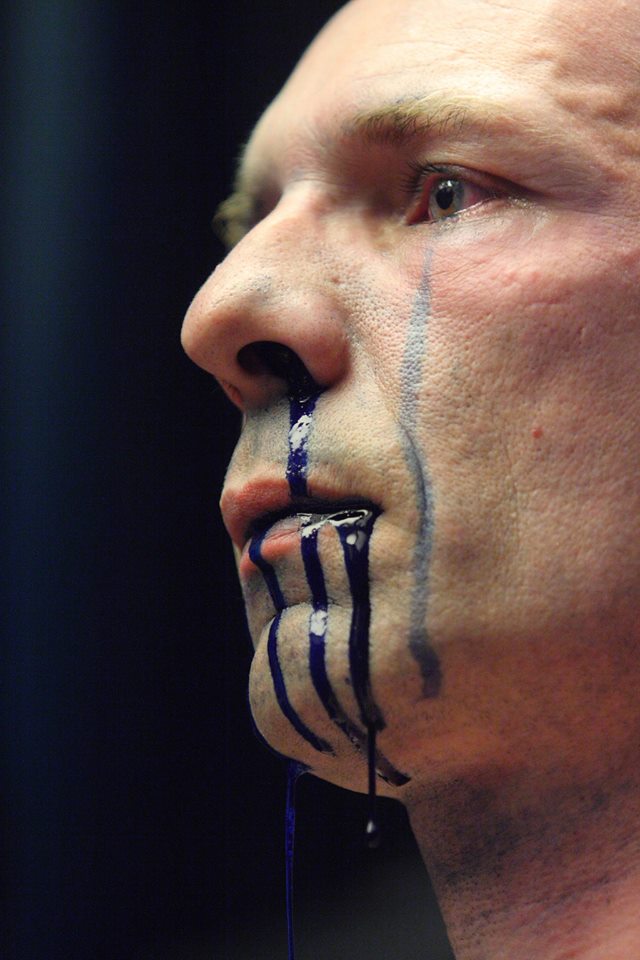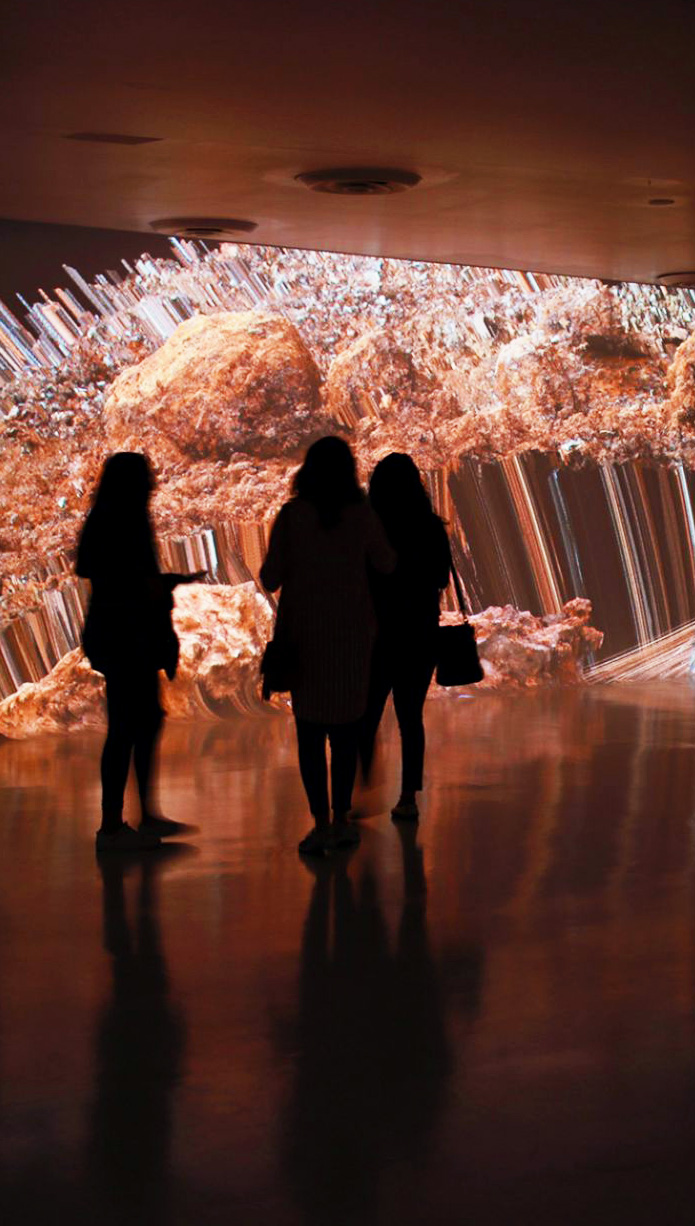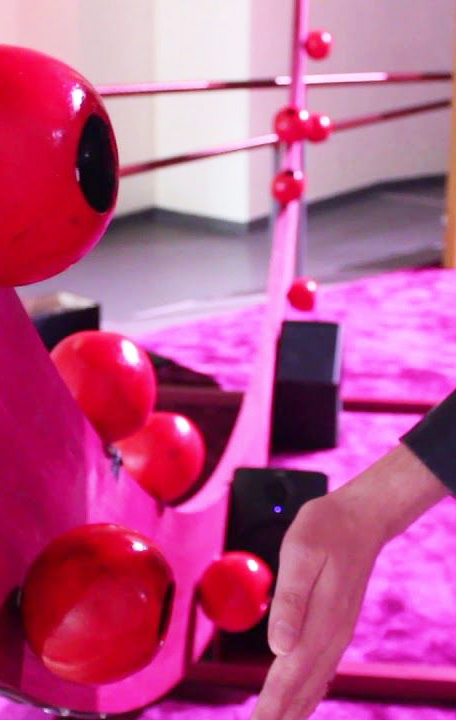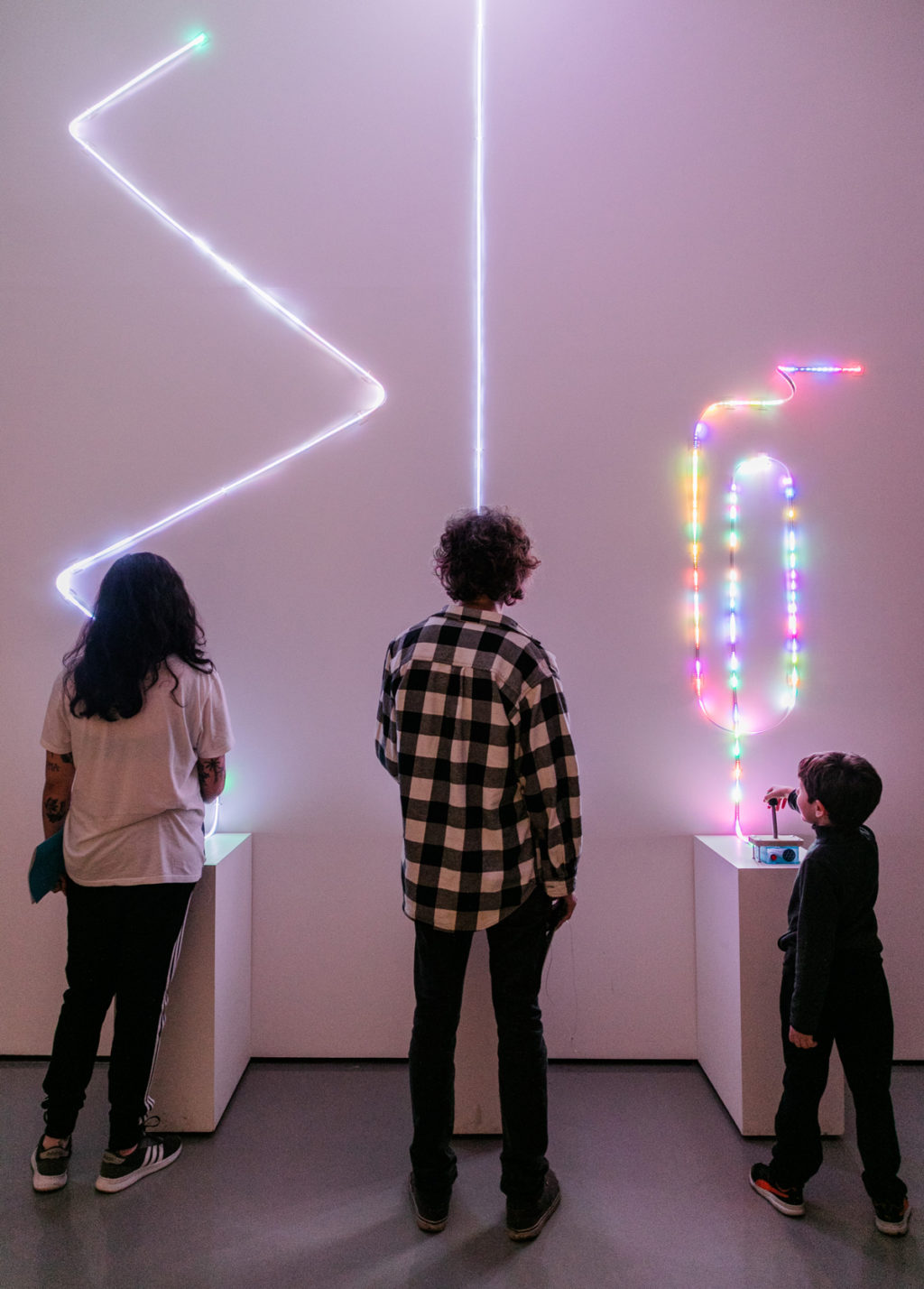
QUBIT AI: Michael Sadowski (aka derealizer)
In Love
FILE 2024 | Interator – Sound Synthetics
International Electronic Language Festival
Michael Sadowski (aka derealizer) – In Love – Austria
Fractal structures move to the sound of progressive house as the virtual camera navigates through this fractal world. To intensify the psychedelic quality, a second layer contrasts with the movement, resulting in a joyful madness of colors.
Bio
Using Stable Diffusion, a visual synthesizer, the artist turns fantasies into videos using just a PC, similar to the invention of printing 600 years ago. Exploring the interplay between software algorithms that create visual worlds and the artist’s mind guiding this process is incredibly exciting. Unlike traditional cinema, there is no ‘reality’ or humans involved, making it a satisfying medium for creating visual art.
Credits
Music: Y do I

Lu Yang
The Great Adventure of Material World
FILE FESTIVAL
The Great Adventure in Material World/Material World Knight is the most adventurous video game artwork that Lu Yang has created. The Great Adventure in Material World/Material World Knight has combined all the protagonists in Lu Yang’s artworks from the past and created an alliance of these heroes. In this video game, the world can be indefinitely explored by players. It has also incorporated several other elements created in various works from the artist before”. Once players enter the video game, they will transform into knights in this Material World. As protagonists of the alliance of heroes in the Material World, they will explore the Universe, absorb energy, be destroyed and achieve rebirth. They will fight all sorts of emotions, desires and eventually with themselves.

Yann Marussich
Bleu Remix
In his spectacle-installation Bleu Remix, Yann Marussich returns to a theme originally explored in Bleu Provisoire (2001), a spectacle in which a mysterious blue liquid oozes through the layers of his skin as though it were the final effect or by-product of his body’s inner processes. In Bleu Remix, the artist once more invites the viewer to experience an intimate journey through the corners of his body. Each time the spectacle is performed, a different (local) musician accompanies Marussich. This unique, singular confrontation establishes a new relationship between the sound and image. The meeting of the two artists brings an element of risk and uniqueness to the event, as if the music explores the spectacle repeatedly, resulting in new ways of perception.

Ian Cheng
“Entropy Wrangler,” Ian Cheng’s 2013 exhibition at Off Vendome in Dusseldorf, was an excellent introduction to the logic behind this artist’s practice. The centerpiece was a large projection in the gallery’s basement described as “a live computer simulation that changes and evolves, forever.” Like all of Cheng’s simulations, it was programmed with motion capture techniques that register the physical movements of performers that are then translated onto digital bodies. These bodies coexist as individual entities subject to the laws and dynamics of a causal, virtual world: avatars of people and common objects, like hammers and basketball players, rendered in basic three-dimensional form and caught in the zero gravity of the digital screen

Jakob Kudsk Steensen
Liminal Lands
Liminal Lands is an environmental multiplayer experience shared by four people at the same time. Each person transforms into the basic elements controlling life across the landscape: Algae, salt, water and mud. As they embark on a communal ritual experience, people morph and change throughout their journey, exploring each new world from a changed perspective of the landscape. Visitors move across different scales and global weather conditions, shedding their human perspective as they are pulled into six different realms inspired by the macro-landscape.

François Quévillon
Pyroclastic Trails
The work shows volcanic rocks rising from the ground that create trails of pixels. The layering of tezontle is generated by a software by modifying the size, speed, trajectory and selection of rocks from a database of photogrammetric 3D scans. Made in November 2019 in collaboration with UNAM’s Instituto de Geografía during a residency for Connecting the Dots, the work is related to research on the impact of mining activities in extinct volcanoes of Sierra de Santa Catarina located south of Mexico City. The video also shows Orbiting Bauxite and 3542 of the Meteors body of works.

FONG QI WEI
퐁 치 웨이
‘Time is a Dimension’
The beauty of photography, in its essence, is conveyed by capturing a moment in time and freezing it out of its context. Singapore-based photographer Fong Qi Wei, however, uses photography to show the passage of time. In his time lapse series called ‘Time is a Dimension’, Fong doesn’t use a typical long exposure trick. He captures the passing time by layering different photos of the same spot with clear edge lines of each frame. Each collage is digitally cut and created from pictures Fong takes within 2 to to 4 hours. Fong usually works at sunrise or sunset, as the light and color palettes are most varied at those times.
“The basic structure of a landscape is present in every piece. But each panel or concentric layer shows a different slice of time, which is related to the adjacent panel/layer. The transition from daytime to night is gradual and noticeable in every piece, but would not be something you expect to see in a still image. Similarly, our experience of a scene is more than a snapshot,” explains Fong.

One Life Remains: André Berlemont, Kevin Lesur, Brice Roy & Franck Weber
FILE SAO PAULO 2017
LES DISCIPLINES DU RECTANGLE
Inspired by Michel Foucault’s work, Les disciplines du rectangle is a videogame proposition about the nature of rules and norms at the digital age. If society provides models of accomplishment we are supposed to fit inside, then the rectangle is the pure abstraction of this idea. The geometrical shape works as a symbol of the very nature of normativity, blind to individual differences. The rectangle, existing only on the screen, reveals how digital technologies can in some ways become the new location for this normativity and the ambivalent results of their intangible and invisible nature. Besides, the installation offers an occasion to think about the way games can become manipulation tools. The fact that in the end, players act as if they were piloted by the rectangle (an inversion of the traditional relationship between player and avatar) gives an aesthetical highlight to this.
.
Inspirado en el trabajo de Michel Foucault, Les disciplines du rectangle es una propuesta de videojuego sobre la naturaleza de las reglas y normas en la era digital. Si la sociedad proporciona modelos de realización en los que se supone que encajamos, entonces el rectángulo es la pura abstracción de esta idea. La forma geométrica funciona como símbolo de la naturaleza misma de la normatividad, ciega a las diferencias individuales. El rectángulo, que existe solo en la pantalla, revela cómo las tecnologías digitales pueden convertirse de alguna manera en la nueva ubicación de esta normatividad y los resultados ambivalentes de su naturaleza intangible e invisible. Además, la instalación ofrece la oportunidad de pensar en cómo los juegos pueden convertirse en herramientas de manipulación. El hecho de que, al final, los jugadores actúen como si fueran piloteados por el rectángulo (una inversión de la relación tradicional entre jugador y avatar) le da un toque estético a esto.

Zilvinas Kempinas
Waves
WAVES is an attempt to return to basic experiences provided by light and sound. The intersecting waves of ligh and sound are creating a multi-layered spectrum, which allows us to experience ourselves and others as different wavelengths: either intertwining or dissolving.

Anders Lind and Ulla Karlsson
Skogen/The forest
Skogen/The forest is an interactive sound art exhibition created by Swedish composer Anders Lind in collaboration with Swedish scenographer Ulla Karlsson. THE FOREST is created as a multiplayer orchestra platform for novices (or experts). Within THE FOREST the visitors becomes orchestra performers ready to explore preprocessed sounds from the Swedish forest in combination with sounds from a traditional symphony orchestra. THE FOREST was first exhibited at Norrlandsoperan, Umeå, Sweden in 2019.

JULIAN OLIVER
朱利安·奥利弗
줄리안 올리버
ג’וליאן אוליבר
ジュリアン・オリバー
Джулиан Оливер
Levelhead
FILE FESTIVAL
LevelHead is a spatial memory game. The game takes its inspiration from the “Philosphical Toys” of 18th/19th century Europe and the memory systems (“memory loci”) of the ancient Greeks. levelHead uses a hand-held solid-plastic cube as its only interface. On-screen it appears that each face of the cube contains a little room, each of which are logically connected by doors. In one of these rooms is a character. By tilting the cube, the player directs this character from room to room in an effort to find the exit. Some doors lead nowhere and will send the character back to the room they started in, a trick designed to challenge the player’s spatial memory. Which doors belong to which rooms? There are three cubes (levels) in all, each of them connected by a single door. Players have as a goal to move the character from room to room, cube to cube, in an attempt to find the final exit door of all three cubes. If this door is found, the character will appear to leave the cube, walk across the table surface and vanish. Then the game starts over.

Assocreation
Solar Pink Pong
file festival
Solar Pink Pong” is a hybrid of street and video game. Players of this game can interact with an animated pink sunlight reflection on the street using their bodies and shadows. The device that makes this game possible can be mounted on utility poles or building sides.

Robin Baumgarten
line-wobbler
file 2019
‘Line Wobbler’ is a one-dimensional dungeon crawler with a custom controller made out of a steel spring and a five-metre long LED strip display. The entire game runs on an Arduino, with sound, particle effects and 120+fps. ‘Line Wobbler’ is an award-winning experiment in minimalism in game design, making use of novel input mechanics, retro sound, and the incorporation of physical architectural space into the game. In the game, players navigate obstacles and fight enemies to reach the exit, in a series of increasingly difficult levels. Movement is controlled by bending the Wobble controller forward and back, while enemies are attacked by flicking the spring at them. Obstacles such as lava fields, conveyor belts and slopes challenge the navigation skills of the player.
Quintessenz
Lingering Summer
“Lingering Summer” is a site-specific installation created for the 2019 West Bund Art Fair. The gradation of colors from yellow to lime green, and indigo to cerulean blue, is reminiscent of the dynamics of changing colors from early to mid-summer. The ascending and descending of layers create a natural and comforting rhythm, as if forming a virtual space to preserve the summer scene inside the steel and concrete architecture, mesmerizing the audience by breaking them away from reality.

GIUSEPPE LICARI
朱塞佩 利卡里
The sky in a room
“Nature has always been a big passion and the relation of nature and man-made environments is something I often try to confront in my work. The Sky in a Room was first inspired by the forests’ fires that in 2007 destroyed a big part of the south of Europe. They were largely man-made fires, intending to generate new land available for building speculation. A sick tree was cut down by the municipality of Rotterdam, cut in smaller pieces, archived and re-built inside the exhibition space, against the architectural surfaces of the gallery. The trunk of the tree was removed in order to give the public a different physical relation to the tree itself and to the white sterilized space of the gallery. The dead tree presents its branches covered with a layer of moss and molds creating a suspended landscape.”

Oliver Laric
2000 Cliparts
Oliver Laric’s work seeks to parse the productive potential of the copy, the bootleg, and the remix, and examine their role in the formation of both historic and contemporary image cultures. This process is intimately tied to his intuitive, idiosyncratic brand of scholarship, which he presents through an ongoing series of fugue-like expository videos (Versions, 2009—present), and further elaborates through his appropriated object works, videos, and sculptures, all of which are densely conceptually layered and often make use of recondite, technologically sophisticated methods of fabrication. Straddling the liminal spaces between the past and the present, the authentic and the inauthentic, the original and its subsequent reflections and reconfigurations, Laric’s work collapses categories and blurs boundaries in a manner that calls into question their very existence.

FREUDENTHAL AND VERHAGEN
Horse And Rider
“The images are, over the years, diverse in discipline and form, but always show a sense of disturbance and a multi layered story. This has resulted in a body of work with an unique personal handwriting and markable face.
Carmen and Elle have created all look-books and art-directing several shows for Bernhard Willhelm from 2001 till 2007. For recent exhibitions they integrated photography with 3-dimensional installations, projected video on photographs and printed photographs on draped silk sheets.”

LAURA LYNN JANSEN AND THOMAS VAILLY
Inner Fashion
Inner Fashion questions the codes, rules and production technic of fashion. The human body is seen as a fluid, inflatable and mobile structure in which the tension of fabric remplace muscles. Each piece of cloth are made of 2 layers: an inner layer, XXS, highly strechable and an outer layer, XL and none strechable. Both layer are dressed on a zeppelin shaped balloon representing the human body. As the balloon fills up with air, the fabric of the inner layer stretches out and both fabric are touching each other.

Sonja Baumel
crocheted membrane
‘Crocheted Membrane’ experiments with creating a momentary fiction through fashion artifacts. Starting with the physical needs of one individual human body in an outdoor temperature of 10 degrees Celsius, seven hand-crocheted body forms were produced. The clothing’s texture got thinner or opened up completely on areas of the body that needed less warmth and were thicker where warmth was lacking. In this way, a fundamental change in the aesthetic and function of clothes was displayed. Fixed forms, such as trousers, were recreated into new, unique body forms. Instead of one uniform surface, the textures became alive and inimitable. “Her concept of clothing does not derive in the same way as most fashion design, from shape or historically patterned form with embedded social hierarchy and material richness, but is instead determined by the needs and sensations of the human body – performing in the same way that bacteria populations individually respond.” (Villeré 2014) The resulting fictional artifacts illustrate how we could use knowledge about our unique bacteria population to create a novel layer.

Kevin Beasley
Strange Fruit
Using both sculpture and musical performance in his practice, Kevin Beasley explores the physical materiality and cultural connotations of both objects and sound. His sculptures typically incorporate everyday items like clothing, housewares, or sporting goods, bound together using tar, foam, resin, or other materials. Often they also contain embedded audio equipment that warps and amplifies the ambient tones of their surroundings. For Storylines, Beasley has created two new works specifically for the Guggenheim’s Frank Lloyd Wright–designed building. Within this vast and open sonic environment, Strange Fruit (Pair 1) and Strange Fruit (Pair 2) (both 2015) offer an experience of intimacy, absorbing and reflecting the sound of the crowd at the scale of a personal conversation. Each work embodies this spirit of dialogue in its two-part structure—at its core are two athletic shoes, one merged with microphones, the other with speakers. Suspending these objects in space, Beasley compounds their technological interchange with additional layers of meaning, bringing to mind the urban phenomenon of shoes hanging from overhead wires or poles (itself an open-ended form of communication). At the same time the works’ titles refer to history of lynchings in the American South memorialized by Bronx schoolteacher Abel Meerepol in the 1937 protest song “Strange Fruit.” In these contexts, the hanging forms of Beasley’s sculptures resonate not only with his body, which molded them by hand, or with the bodies moving through the museum, but also with those inscribed in the problematic history of race and class in the United States.

DILLER + SCOFIDIO
The Blur Building (an architecture of atmosphere)
The Blur Building is a media pavilion for Swiss EXPO 2002 at the base of Lake Neuchatel in Yverdon-les-Bains, Switzerland.From piles in the water, a tensegrity system of rectilinear struts and diagonal rods cantilevers out over the lake. Ramps and walkways weave through the tensegrity system, some of them providing a counterweight for the structure. The form is based on the work of Buckminster Fuller.The pavilion is made of filtered lake water shot as a fine mist through 13,000 fog nozzles creating an artificial cloud that measures 300 feet wide by 200 feet deep by 65 feet high. A built-in weather station controls fog output in response to shifting climatic conditions such as temperature, humidity, wind direction, and wind speed.The public can approach Blur via a ramped bridge. The 400 foot long ramp deposits visitors at the center of the fog mass onto a large open-air platform where movement is unregulated. Visual and acoustical references are erased along the journey toward the fog leaving only an optical “white-out” and the “white-noise” of pulsing water nozzles. Prior to entering the cloud, each visitor responds to a questionnaire/character profile and receives a “braincoat” (smart raincoat). The coat is used as protection from the wet environment and storage of the personality data for communication with the cloud’s computer network. Using tracking and location technologies, each visitor’s position can be identified and their character profiles compared to any other visitor.In the Glass Box, a space surrounded by glass on six sides, visitors experience a “sense of physical suspension only heightened by an occasional opening in the fog.” As visitors pass one another, their coats compare profiles and change color indicating the degree of attraction or repulsion, much like an involuntary blush – red for affinity, green for antipathy. The system allows interaction among 400 visitors at any time.Visitors can climb another level to the Angel Bar at the summit. The final ascent resembles the sensation of flight as one pierces through the cloud layer to the open sky. Here, visitors relax, take in the view, and choose from a large selection of commercial waters, municipal waters from world capitals, and glacial waters. At night, the fog will function as a dynamic and thick video screen.

A.LTER S.ESSIO PERFORMER ART GROUP
A.lter S.essio
“Loss”
via highlike submit
A.lter S.essio的组织Panem Et Circenses负责制作和行政管理,是Fabrice Planquette基于各种艺术合作发起的一个部分。
Fabrice Planquette偶尔邀请各个领域的人共享一个创意空间。 他给出了第一个动力和方向,每个人都有自己的语言,敏锐的感觉和前景。 2007年底,开始创作表演。 该系列已经由LOSS,LAYERS,ENDURANCE,EXTENSION(S)和ASCENSIO开始,并将继续进行SURFACE,DESERT(三重奏)和ENSEMBLE(7位舞者的作品)。 所有这些部分都是相互联系的:套件,互补,并行,对立。 他们遵循着对人类及其所处环境的探索的进步。 与环境,自己,对方面对

LA LA LA HUMAN STEPS
Amelia
Edouard Locke
“Directed and choreographed by Locke in 2002, Amelia, is a beautiful piece of dance on film that won awards and critical acclaim at numerous festivals when it came out. Amelia features a hypnotic, original, minimalist score written by David Lang for violin, cello, piano and voice, and lyrics from five of Lou Reed’s most famous works that he created in the 60s for the Velvet Underground. It is beautifully shot from multiple angles, some dizzying and swooping, in a space that was tailor-made for the film itself. The shadows and lighting in tandem with the shots and the movement add layers of beauty to the stark visuals.” Sarah Elgart

Kian-Peng Ong
Coronado
File festival
“Coronado” was inspired by a visit to the Coronado beach in California, which was an awe inspiring moment never experienced in other beaches. The soundscape present in Coronado seemed to be coming from all directions with layers and layers of sound waves. I decided then that I would make a sound work to translate this experience. The sound installation is characterized by the interplay of the analog and digital sound sources which layers over one another, exploring the idea of a seascape. The center of the installation is an ocean drum controlled with mechanical arms that creates and simulates the sound of sea waves. This is picked up by the microphone, reprocessed through the computer and sent out to the 6 channel surround speakers in different time. The interplay and sense of endlessness in the layering the analog and digital are my interpretation and response to the wonderment I found in Coronado.